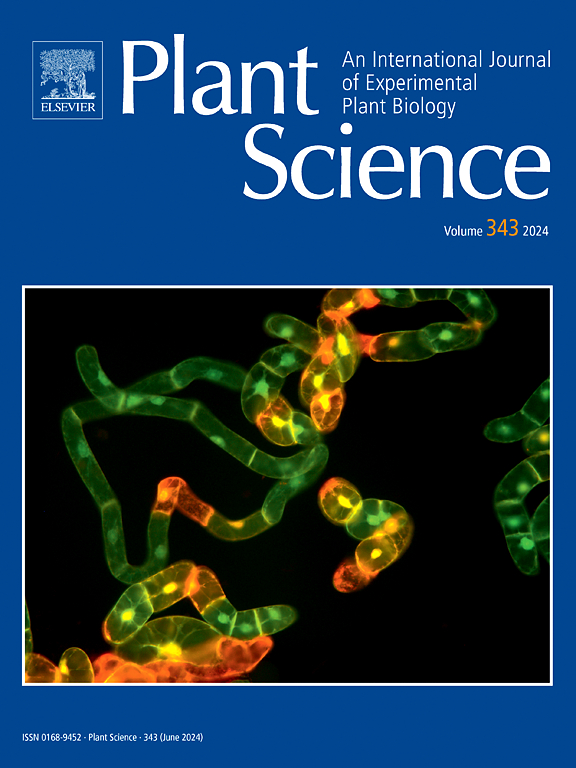Increase of histone acetylation by suberoylanilide hydroxamic acid enhances microspore reprogramming and expression of somatic embryogenesis transcription factors in Brassica napus
IF 4.2
2区 生物学
Q2 BIOCHEMISTRY & MOLECULAR BIOLOGY
引用次数: 0
Abstract
In vivo, microspores in the anthers follow the gametophytic development pathway, culminating in the formation of pollen grains. Conversely, in vitro, under stress treatments, microspores can be reprogrammed into totipotent cells, initiating an embryogenic pathway that produces haploid and double-haploid embryos, which are important biotechnological tools in plant breeding. There is growing evidence that epigenetic reprogramming occurs during microspore embryogenesis through DNA methylation, but less is known about the role of histone modifications. This study investigates the dynamics of histone acetylation during the two microspore developmental pathways, microspore embryogenesis and pollen development, in Brassica napus. We analyzed histone H3 and H4 acetylation levels, histone acetyltransferase (HAT) activity and expression of HAC5 acetyltransferase using immunofluorescence, enzymatic activity assays, ELISA-like tests, and qPCR. Results showed a decrease in global histone acetylation levels during pollen maturation, correlated with reduced HAT activity and downregulation of the BnHAC5-like gene. In contrast, stress-induced microspore reprogramming led to increased histone acetylation levels, enhanced HAT activity, and upregulation of BnHAC5-like. Treatment with suberoylanilide hydroxamic acid (SAHA), a histone deacetylase inhibitor widely used in animal research but barely applied to plants, enhanced microspore embryogenesis initiation and proembryo formation, while increased histone acetylation levels. SAHA-treated proembryos showed higher expression than control of key embryogenesis transcription factors BnFUS3, BnAGL15, and BnLEC2, suggesting that histone hyperacetylation facilitates transcriptional activation of essential genes for somatic embryogenesis initiation. These findings provided new insights into the epigenetic regulation of this process and revealed new opportunities with histone epigenetic regulator inhibitors, to improve microspore embryogenesis induction for crop improvement.
亚伯酰苯胺羟肟酸可提高组蛋白乙酰化水平,从而增强甘蓝型油菜的小孢子重编程和体细胞胚胎发生转录因子的表达。
在体内,花药中的小孢子遵循配子体发育途径,最终形成花粉粒。相反,在体外,在胁迫处理下,小孢子可以重编程为全能细胞,启动胚胎发生途径,产生单倍体和双倍体胚胎,这是植物育种的重要生物技术手段。越来越多的证据表明,在小孢子胚胎发生过程中,会通过 DNA 甲基化发生表观遗传学重编程,但对组蛋白修饰的作用却知之甚少。本研究调查了甘蓝型油菜在小孢子胚胎发生和花粉发育这两个小孢子发育过程中组蛋白乙酰化的动态变化。我们利用免疫荧光、酶活性测定、类酶联免疫吸附试验和 qPCR 分析了组蛋白 H3 和 H4 乙酰化水平、组蛋白乙酰转移酶(HAT)活性和 HAC5 乙酰转移酶的表达。结果表明,在花粉成熟过程中,全局组蛋白乙酰化水平下降,这与 HAT 活性降低和 BnHAC5 样基因下调有关。相反,胁迫诱导的小孢子重编程导致组蛋白乙酰化水平升高、HAT活性增强和BnHAC5-like基因上调。亚伯酰苯胺羟肟酸(SAHA)是一种组蛋白去乙酰化酶抑制剂,广泛用于动物研究,但很少用于植物。经 SAHA 处理的原胚胎显示出比对照组更高的胚胎发生关键转录因子 BnFUS3、BnAGL15 和 BnLEC2 的表达量,这表明组蛋白超乙酰化促进了体细胞胚胎发生启动所必需基因的转录激活。这些发现为这一过程的表观遗传调控提供了新的见解,并揭示了组蛋白表观遗传调控抑制剂的新机遇,从而改善小孢子胚胎发生诱导,促进作物改良。
本文章由计算机程序翻译,如有差异,请以英文原文为准。
求助全文
约1分钟内获得全文
求助全文
来源期刊

Plant Science
生物-生化与分子生物学
CiteScore
9.10
自引率
1.90%
发文量
322
审稿时长
33 days
期刊介绍:
Plant Science will publish in the minimum of time, research manuscripts as well as commissioned reviews and commentaries recommended by its referees in all areas of experimental plant biology with emphasis in the broad areas of genomics, proteomics, biochemistry (including enzymology), physiology, cell biology, development, genetics, functional plant breeding, systems biology and the interaction of plants with the environment.
Manuscripts for full consideration should be written concisely and essentially as a final report. The main criterion for publication is that the manuscript must contain original and significant insights that lead to a better understanding of fundamental plant biology. Papers centering on plant cell culture should be of interest to a wide audience and methods employed result in a substantial improvement over existing established techniques and approaches. Methods papers are welcome only when the technique(s) described is novel or provides a major advancement of established protocols.
 求助内容:
求助内容: 应助结果提醒方式:
应助结果提醒方式:


